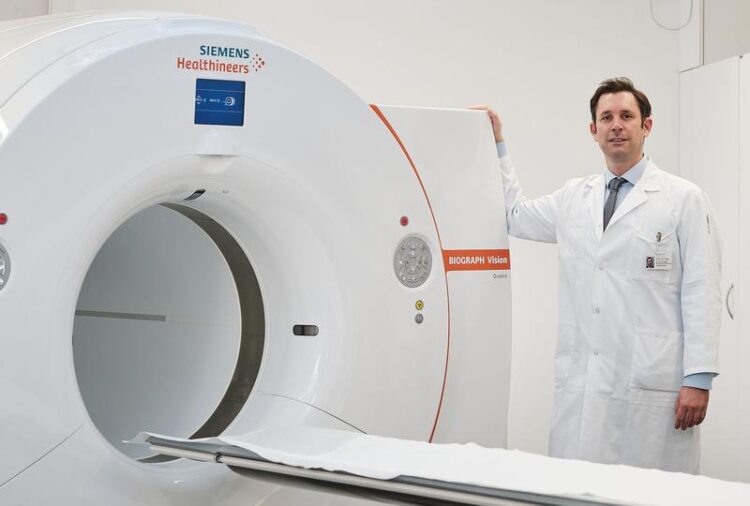Whole-body PET/CT: World’s first installation in Bern

Prof. Dr. med. Axel Rominger, Klinikdirektor und Chefarzt Universitätsklinik für Nuklearmedizin, Inselspital Bern
Pascel Gugler / Insel Gruppe
The world’s fastest whole-body PET/CT scanner is being put into service today at Bern University Hospital’s Inselspital Department of Nuclear Medicine. This scanner of the latest generation opens up new dimensions in research, diagnostics and therapy planning. The manufacturer (Siemens Healthineers) chose Bern as the location for the first installation worldwide because of its top-class research, its proven concept for networked operation and its role as a leading center in medicine.
Positron emission tomography (PET) is a diagnostic imaging procedure in nuclear medicine that produces cross-sectional images of the body by making weakly radioactively labelled substances (radiopharmaceuticals) visible. Tumours, for example, often have an intensive metabolism of sugar or express receptors that can be made visible in PET. A similar situation applies to the diagnosis of neurodegenerative diseases, where one often sees reduced levels of sugar metabolism in the brain. Today’s PET scanners are combined with a computer tomograph (CT), which can visualise anatomical structures, such as bones and tissue, thus enabling the PET signal to be precisely located in the body.
New dimensions in PET/CT scanning
“The new PET/CT scanner, which is going into operation at the Department of Nuclear Medicine, is a real milestone”, Prof. Axel Rominger was delighted to say. “With a field of view extended over 106 cm, it is now for the first time possible to produce PET/CT images of the entire head and torso at one go. This means that, for the first time, actual 4D images of a large section of the body can be produced”. What is more, the technology has become faster by several orders of magnitude and is more sensitive. Prof. Axel Rominger pointed out the following advantages for patients: “On the one hand, the time required for imaging can be shortened, and on the other, the radioactivity levels for the radiopharmaceuticals can be reduced, which makes for lower exposure”.
Ideally integrated into the University Hospital
The location in Bern offers the special advantage that it allows the PET/CT scanner to be integrated into a large-scale university research environment that is also a clinical one. The possibilities for interdisciplinary, innovative research activities are manifold. Cancer research, initiated and facilitated by Tumorzentrum Bern UCI (University Cancer Center Inselspital) is driven forward across rearch networks. Neuromedicine in Bern, that is to say the Department of Neurology at the Bern University Hospital, provides excellent conditions for investigating neurological issues.
A regionally interconnected operating concept
The fact that PET Diagnotik Bern AG is fully integrated into the medical landscape of Bern opens the way for an efficient operational concept benefiting from existing regional networks. The company was founded in 2001 by Inselspital and the former Sonnenhof AG as well as private shareholders. Peter Kappert, chairman of the board of directors, explained: “It did not take long to bring on board other hospitals (Lindenhofspital and Spitalzentrum Biel) in the canton as well as shareholders. In a shareholder agreement, we undertook not to operate additional devices at other locations, thus ensuring there would not be an ‘arms race’ in the canton”. On the one hand, regional connectivity will make it possible to operate the device profitably despite the high investments, and on the other, we were able to place PET diagnostics in the hands of a team of superbly qualified team at the Department of Nuclear Medicine.
Outlook for the location as a center for medicine
Bern’s standing as a medical hub was born out of many years of commitment on the part of policymakers, business and the university. The general manager of Insel Gruppe, Uwe E. Jocham, resolutely pursues the vision of the hospital group as a worldwide leader: “The new PET/CT scanner will contribute to realizing and sustaining this vision of Insel Gruppe. It will also help us to combine leading-edge medical services and offerings of decentralised healthcare at urban and rural hospitals”.
The importance of this new facility is also being highlighted at the political level. “We are living through challenging times and are struggling with the consequences of a pandemic of unprecedented proportions”, emphasised Alain Schnegg, member of the cantonal government: “If the current situation teaches us anything, it is this: A good, high-performing and innovative healthcare system is of utmost importance, now and in the future”.
Wissenschaftliche Ansprechpartner:
Prof. Dr. med. Axel Rominger, Department of Nuclear Medicine, Chairman of the Department und Chief Physician
Weitere Informationen:
http://www.insel.ch: Check the news with videos and galleries
Media Contact
All latest news from the category: Medical Engineering
The development of medical equipment, products and technical procedures is characterized by high research and development costs in a variety of fields related to the study of human medicine.
innovations-report provides informative and stimulating reports and articles on topics ranging from imaging processes, cell and tissue techniques, optical techniques, implants, orthopedic aids, clinical and medical office equipment, dialysis systems and x-ray/radiation monitoring devices to endoscopy, ultrasound, surgical techniques, and dental materials.
Newest articles

Silicon Carbide Innovation Alliance to drive industrial-scale semiconductor work
Known for its ability to withstand extreme environments and high voltages, silicon carbide (SiC) is a semiconducting material made up of silicon and carbon atoms arranged into crystals that is…

New SPECT/CT technique shows impressive biomarker identification
…offers increased access for prostate cancer patients. A novel SPECT/CT acquisition method can accurately detect radiopharmaceutical biodistribution in a convenient manner for prostate cancer patients, opening the door for more…

How 3D printers can give robots a soft touch
Soft skin coverings and touch sensors have emerged as a promising feature for robots that are both safer and more intuitive for human interaction, but they are expensive and difficult…





















